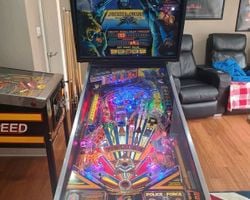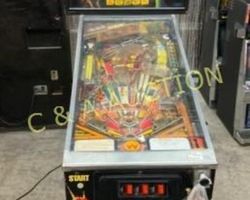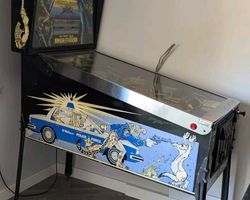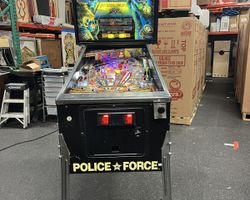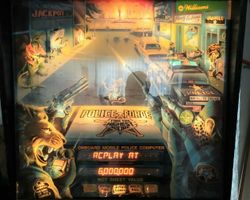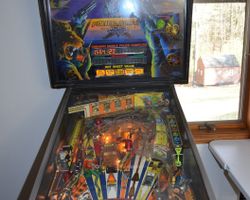Police Force
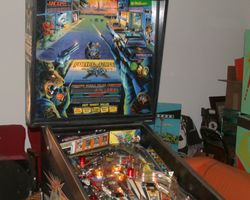
Average Prices: USD $300 to $1,400
Produced: August, 1989
Production Run: 4,700 units
Machine Type: Solid State Electronic
MPU: Williams System 11B
Players: 4
Design by: Barry Oursler, Mark Ritchie
Art by: John Youssi, Python Anghelo
Mechanics by: Joe Joos Jr., Jack Skalon, Irv Grabel
Music by: Chris Granner
Sound by: Chris Granner
Software by: Bill Pfutzenreuter
"Police Force," released by Williams in August 1989, delivers a high-speed chase into the world of law enforcement, offering players a dynamic pinball experience centered around catching criminals and upholding justice. This machine, born from a creative pivot and brought to life by a team of pinball artisans, stands as a testament to the engaging gameplay and thematic storytelling that defined the era of solid-state pinball.
History and Background
Developed during a period of intense competition in the pinball industry, "Police Force" emerged from an intriguing change of direction. Initially conceived as a licensed "Batman" pinball machine, the project underwent a significant thematic shift when Data East secured the rights to the caped crusader. Faced with this licensing hurdle, the Williams team, under the conceptual guidance of Python Anghelo, deftly reimagined their creation, transforming the Batmobile into a police car and the Bat Cave into a jail. This quick adaptation demonstrates the industry's agility and the creative spirit driving pinball design.
The design team behind "Police Force" was a powerhouse of talent. Barry Oursler and Mark Ritchie spearheaded the game design, crafting the ruleset and playfield layout. The distinctive visual style, blending action with a touch of cartoonish charm, came from the combined artistry of John Youssi and Python Anghelo. Bill Pfutzenreuter programmed the software, while Chris Granner composed the game's music and sound effects, creating an auditory landscape that complements the theme. Mechanical engineering was handled by Irv Grabel, Jack Skalon, and Joe Joos Jr., ensuring the physical elements of the machine functioned seamlessly. Mark and Steve Ritchie contributed to the game's engaging callouts, further enhancing the player experience with vocal cues and thematic phrases.
"Police Force" entered production on August 1, 1989, bearing model number 573 and Williams System 11B MPU. A total of 4,751 units were manufactured between August and November 1989, with the first machines shipping on August 7th and the final units dispatched by December 19th. Promotional items for the game included a toy car, notepad, and hat, adding to the marketing push for what was advertised as "The world's most wanted pinball!" An interesting piece of pinball trivia connects "Police Force" to Williams' earlier title "Taxi" (1988), also designed by Mark Ritchie. The yellow limousine taxi featured in the backglass artwork of "Police Force" is a direct visual callback to "Taxi," a subtle nod for observant players and a touch of design consistency across Ritchie's portfolio.
Signature Features and Design
"Police Force" is immediately recognizable for its standout features that contribute to its thematic appeal and gameplay excitement. The most prominent toy is the moving police car situated on the left side of the playfield. This car is not merely a static decoration; it actively participates in gameplay, dropping pinballs onto the playfield during multiball sequences, adding a dynamic and visually engaging element to the game.
Another striking feature is the police light beacon and speaker backbox topper. This illuminated topper, reminiscent of emergency vehicle lights, enhances the game's law enforcement theme and draws attention in an arcade or home setting. The artwork, a collaborative effort between John Youssi and Python Anghelo, is vibrant and detailed, depicting a cast of characters engaged in a cops-and-robbers narrative. The playfield and backglass art utilize bright colors and dynamic compositions to immerse players in the world of police action.
Custom speech callouts, voiced in part by Mark Ritchie, are integral to the game's personality. These voice cues provide feedback, announce game events, and inject humor, keeping players engaged and informed throughout their gameplay session. The combination of these elements – the moving car, the police beacon, the distinctive artwork, and the custom speech – creates a cohesive and immersive pinball experience that defines "Police Force".
Playfield and Mechanics
The playfield of "Police Force" is designed for fast-paced action and intuitive shot-making, characteristic of Williams System 11B games. It features a balanced layout that encourages players to utilize all areas of the playfield. Two ramps are central to the gameplay, providing satisfying shot opportunities and contributing to game progression. Three pop bumpers are strategically placed to create chaotic ball movement and increase the energy of the play. Six drop targets add a layer of accuracy-based challenges, while three kick-out holes serve as ball eject mechanisms and targets for specific game modes.
A key feature related to skill is the manual plunger, which launches the ball into a rollunder spinner lane. This skill shot offers random awards, encouraging players to master the plunge for early game advantages. The right ramp incorporates a diverter, a mechanical element that directs the ball either to a lock area for multiball initiation or onto a habitrail leading back to the left inlane. This diverter adds an element of unpredictability and strategic choice to ramp shots.
The playfield artwork complements the overall theme, with illustrations of police officers, criminals, and cityscapes reinforcing the cops-and-robbers motif. Lighting is used effectively to highlight key playfield features and create visual excitement, particularly during multiball and special modes. The aesthetic is designed to be engaging and easy to read, ensuring players can quickly identify targets and understand the playfield layout.
Gameplay Dynamics
"Police Force" offers accessible yet engaging gameplay dynamics, built around a core objective of catching criminals and accumulating points. The game features a two-ball multiball mode, initiated by locking balls, which ramps up the scoring potential and excitement. The scoring system is designed to reward a variety of shots, but the center ramp quickly became known for its "unlimited millions" potential, allowing skilled players to rack up exceptionally high scores by repeatedly hitting this shot.
Unique modes and objectives contribute to the game's replayability. The "shooting range" skill shot, achievable from the plunger, provides an initial challenge and reward. However, one of the most talked-about gameplay elements is the "steal highest score" mechanic. This feature allows a player achieving a high score to potentially have it taken by a subsequent player who surpasses their total, introducing a competitive edge and sometimes controversial dynamic, particularly in multiplayer games.
Gameplay is generally fast and flowing, encouraging players to keep the ball in motion and utilize ramps, targets, and bumpers to maximize their score. Strategies often revolve around mastering the center ramp shot for high scoring, while also engaging with drop targets and kick-out holes to trigger modes and advance game progression. The game's ruleset is relatively straightforward, making it easy for new players to pick up and enjoy, while still offering enough depth to keep experienced players engaged, at least for casual play.
Reception and Legacy
"Police Force" garnered a mixed reception within the pinball community, a reflection of its accessible gameplay and specific design choices. Positive feedback consistently highlights the game's fun factor and broad appeal, particularly for casual players and families. Reviewers often praise the artwork, sound effects, and music for their thematic integration and ability to enhance the overall excitement. The multiplayer features, including the "steal highest score" mechanic, are acknowledged as adding a layer of competitive fun, although this feature is also a point of contention for some. Many appreciate the quick gameplay, making it suitable for shorter play sessions and accessible to players of varying skill levels.
However, criticism often centers on the repetitive scoring associated with the center ramp, which some perceive as diminishing the game's long-term depth and competitive viability. The "one-trick pony" label arises from the perception that mastering the center ramp shot overshadows other aspects of the game. The "steal high score" feature, while intended to be competitive, is sometimes viewed as unbalanced or unfair. Some players have also noted concerns about the durability of certain game components, particularly the center ramp, under heavy use.
Despite these criticisms, "Police Force" retains a place in pinball history as an example of a theme-driven, approachable game from the System 11B era. While it may not be considered a top-tier tournament machine due to its scoring balance and perceived lack of depth for highly skilled players, it is appreciated for its engaging theme, vibrant presentation, and enjoyable gameplay experience. Its legacy lies in its ability to provide accessible pinball fun, capturing the spirit of late 1980s pinball design with its blend of action, humor, and thematic storytelling.
 Active Auctions
Active Auctions
 Auction Results
Auction Results
| Cost | Location | Date |
|---|---|---|
| USD $2,100 |  California, United States California, United States |
04 April, 2025 |
| GBP £1,537 |  London, United Kingdom London, United Kingdom |
07 March, 2025 |
| USD $2,800 |  Michigan, United States Michigan, United States |
18 February, 2025 |
| GBP £1,318 |  London, United Kingdom London, United Kingdom |
15 February, 2025 |
| GBP £1,750 |  Chelmsford, United Kingdom Chelmsford, United Kingdom |
23 October, 2024 |
| USD $2,400 |  Pennsylvania, United States Pennsylvania, United States |
16 September, 2024 |
| USD $2,995 |  California, United States California, United States |
19 July, 2024 |
| USD $2,350 |  Michigan, United States Michigan, United States |
07 July, 2024 |
| USD $2,989 |  Florida, United States Florida, United States |
26 June, 2024 |
| USD $2,989 |  Florida, United States Florida, United States |
26 April, 2024 |


Private Policy · Search Website · Contact Us
All trademarks and copyrighted materials remain property of their respective owners.
All other content copyright 2007 - 2025 Pinpedia.

